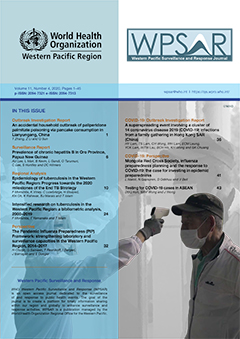An accidental household outbreak of paliperidone palmitate poisoning via pancake consumption in Lianyungang, China
DOI:
https://doi.org/10.5365/wpsar.2019.10.1.005Abstract
Introduction: At 11:20 on 26 May 2018, a physician from Lianyungang No. 1 People’s Hospital, China, reported that six family members were being treated in the hospital with symptoms from an unknown cause.
Methods: A case series for a food poisoning investigation and an environmental survey were conducted. The patients and their relatives were interviewed in person with a questionnaire contained on a digital tablet, and an investigation of the patients’ home was conducted in the presence of police officers. Probable case and confirmed case were defined to serve as a basis for identifying additional cases. Confirmed cases were defined as those probable cases in which blood, stool or vomitus specimens tested positive for paliperidone palmitate and/or its metabolites. A descriptive analysis was performed. Follow-up by telephone was conducted four months later.
Results: There were six probable cases. The median age was 35 years (range: 5–76 years). The attack rate was 100% (n = 6/6) of persons who consumed a family dinner, and the hospitalization rate was also 100% (n = 6/6). The median period between exposure and symptom onset was two hours. The main symptoms included vomiting, nausea, drowsiness, dizziness and severe abdominal pain for adults, and vomiting and severe lethargy for children. An 8-year-old girl further showed changes in the ST segment of her electrocardiogram, and a 5-year-old boy showed QT prolongation. The poisoning substance was suspected to be paliperidone palmitate based on the patients’ symptoms and epidemiological findings.
Discussion: We investigated the household food poisoning outbreak through epidemiological analysis and an environmental investigation and determined that it was caused by paliperidone palmitate. The source of the paliperidone palmitate was found to be aluminium containers, taken home by the eldest son who worked at a pharmaceutical company. The containers were sent to a drug disposal centre, and the pharmaceutical company was required to enhance the regulation on the pharmaceutical waste materials to prevent drug poisoning events. By the end of September 2018, the six patients recovered and were released from the hospital, and they did not show any clinical sequelae in four follow-up visits.
References
Emsley R, Kilian S. Efficacy and safety profile of Paliperidone Palmitate injections in the management of patients with schizophrenia: an evidence-based review. Neuropsychiatr Dis Treat. 2018; 14:205-223. DOI: 10.2147/NDT.S139633. PMID:29379293.
Corena-McLeod M. Comparative pharmacology of Risperidone and Paliperidone. Drugs R D. 2015;15(2):163-174. DOI:10.1007/s40268-015-0092-x. PMID: 25943458.
Gopal S, Hough DW, Xu H, et al. Efficacy and safety of Paliperidone Palmitate in adult patients with acutely symptomatic schizophrenia: a randomized, double-blind, placebo-controlled, dose-response study. Int Clin Psychopharmacol. 2010;25(5):247-256. DOI: 10.1097/YIC.0b013e32833948fa.
PMID: 20389255.
Pandina GJ, Lindenmayer JP, Lull J, et al. A randomized, placebo-controlled study to assess the efficacy and safety of 3 doses of Paliperidone Palmitate in adults with acutely exacerbated schizophrenia. J Clin Psychopharmacol. 2010;30(3):235-244. DOI:10.1097/JCP.0b013e3181dd3103.
PMID: 20473057.
Gopal S, Vijapurkar U, Lim P, Morozova M, Eerdekens M, Hough D. A 52-week open-label study of the safety and tolerability of Paliperidone Palmitate in patients with schizophrenia. J Psychopharmacol. 2011;25(5):685-697.
DOI: 10.1177/0269881110372817. PMID: 20615933.
Li H, Rui Q, Ning X, Xu H, Gu N. A comparative study of Paliperidone Palmitate and risperidone long-acting injectable therapy in schizophrenia. Prog Neuropsychopharmacol Biol Psychiatry. 2011;35(4):1002-1008.
DOI: 10.1016/j.pnpbp.2011.02.001. PMID: 21315787.
Zhao J, Li L, Shi J, et al. Safety and efficacy of Paliperidone Palmitate 1-month formulation in Chinese patients with schizophrenia: a 25-week, open-label, multicenter, Phase IV study. Neuropsychiatr Dis Treat. 2017;13:2045-2056.
DOI: 10.2147/NDT.S131224. PMID: 28814873.
Zhang F, Si T, Chiou CF, et al. Efficacy, safety, and impact on hospitalizations of Paliperidone Palmitate in recent-onset schizophrenia. Neuropsychiatr Dis Treat. 2015;11:657-668. DOI: 10.2147/NDT.S77778. PMID: 25792835.
Berwaerts J, Liu Y, Gopal S, et al. Efficacy and safety of the 3-month formulation of Paliperidone Palmitate vs placebo for relapse prevention of schizophrenia: a randomized clinical trial. JAMA Psychiatry. 2015;72(8):830-839.
DOI: 10.1001/jamapsychiatry.2015.0241. PMID: 25820612.
Lamb YN, Keating GM. Paliperidone Palmitate intramuscular 3-monthly formulation: a review in schizophrenia. Drugs. 2016;76(16):1559-1566.
DOI: 10.1007/s40265-016-0645-5. PMID: 27699643.
Hargarter PL, Cherubin P, Bergmans P, et al. Intramuscular long-acting Paliperidone Palmitate in acute patients with schizophrenia unsuccessfully treated with oral antipsychotics. Prog Neuropsychopharmacol Biol Psychiatry. 2015;58:1-7. DOI:10.1016/j.pnpbp.2014.11.006. PMID: 25448776.
Yong P. Efficacy and safety of Piperidone Palmitate injection in first-episode schizophrenia. Cardiovascular Disease Journal of integrated traditional
Chinese and Western Medicine. 2018;18(6):98-99. DOI:10.16282/j.cnki.cn11-9336/r.2018.18.073.
Zhaoyu H, Sheng W, Lu L, et al. Comparative Study and Economic Evaluation on Palioprostone Palmitate Injection and Paliperidone Extended-release Tablets in Treatment of Schizophrenia. Evaluation and analysis of drug-use in hospitals of China. 2017;6(17):792-795.
DOI:10. 14009 / j.issn.1672-2124.2017.06.027.
Jihong Q, Xiaoping C. Clinical Evaluation on Paliperidone Palmitate Injection in Treating Schizophrenia in 45 Cases. China Pharmaceuticals. 2018;14(27):38-40.
DOI: 10. 3969 / j. Issn.1006-4931.2018.14.013.

